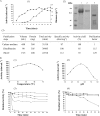Gene overexpression and biochemical characterization of the biotechnologically relevant chlorogenic acid hydrolase from Aspergillus niger
- PMID: 17630312
- PMCID: PMC2042068
- DOI: 10.1128/AEM.00374-07
Gene overexpression and biochemical characterization of the biotechnologically relevant chlorogenic acid hydrolase from Aspergillus niger
Abstract
The full-length gene that encodes the chlorogenic acid hydrolase from Aspergillus niger CIRM BRFM 131 was cloned by PCR based on the genome of the strain A. niger CBS 513.88. The complete gene consists of 1,715 bp and codes for a deduced protein of 512 amino acids with a molecular mass of 55,264 Da and an acidic pI of 4.6. The gene was successfully cloned and overexpressed in A. niger to yield 1.25 g liter(-1), i.e., 330-fold higher than the production of wild-type strain A. niger CIRM BRFM131. The histidine-tagged recombinant ChlE protein was purified to homogeneity via a single chromatography step, and its main biochemical properties were characterized. The molecular size of the protein checked by mass spectroscopy was 74,553 Da, suggesting the presence of glycosylation. ChlE is assembled in a tetrameric form with several acidic isoforms with pIs of around 4.55 and 5.2. Other characteristics, such as optimal pH and temperature, were found to be similar to those determined for the previously characterized chlorogenic acid hydrolase of A. niger CIRM BRFM 131. However, there was a significant temperature stability difference in favor of the recombinant protein. ChlE exhibits a catalytic efficiency of 12.5 x 10(6) M(-1) s(-1) toward chlorogenic acid (CGA), and its ability to release caffeic acid from CGA present in agricultural by-products such as apple marc and coffee pulp was clearly demonstrated, confirming the high potential of this enzyme.
Figures






Similar articles
-
Purification and characterization of a chlorogenic acid hydrolase from Aspergillus niger catalysing the hydrolysis of chlorogenic acid.J Biotechnol. 2005 Jan 12;115(1):47-56. doi: 10.1016/j.jbiotec.2004.07.009. J Biotechnol. 2005. PMID: 15607224
-
Homologous expression of the feruloyl esterase B gene from Aspergillus niger and characterization of the recombinant enzyme.Protein Expr Purif. 2004 Sep;37(1):126-33. doi: 10.1016/j.pep.2004.05.019. Protein Expr Purif. 2004. PMID: 15294290
-
A novel glucose dehydrogenase from the white-rot fungus Pycnoporus cinnabarinus: production in Aspergillus niger and physicochemical characterization of the recombinant enzyme.Appl Microbiol Biotechnol. 2014 Dec;98(24):10105-18. doi: 10.1007/s00253-014-5891-4. Epub 2014 Jun 26. Appl Microbiol Biotechnol. 2014. PMID: 24965558
-
Fungal epoxide hydrolases: new landmarks in sequence-activity space.Trends Biotechnol. 2004 Mar;22(3):123-9. doi: 10.1016/j.tibtech.2004.01.012. Trends Biotechnol. 2004. PMID: 15036862 Review.
-
[Aspergillus niger as a potential cellular factory: prior knowledge and key technology].Sheng Wu Gong Cheng Xue Bao. 2010 Oct;26(10):1410-8. Sheng Wu Gong Cheng Xue Bao. 2010. PMID: 21218629 Review. Chinese.
Cited by
-
In silico evolution of Aspergillus niger organic acid production suggests strategies for switching acid output.Biotechnol Biofuels. 2020 Feb 24;13:27. doi: 10.1186/s13068-020-01678-z. eCollection 2020. Biotechnol Biofuels. 2020. PMID: 32123544 Free PMC article.
-
An inserted α/β subdomain shapes the catalytic pocket of Lactobacillus johnsonii cinnamoyl esterase.PLoS One. 2011;6(8):e23269. doi: 10.1371/journal.pone.0023269. Epub 2011 Aug 18. PLoS One. 2011. PMID: 21876742 Free PMC article.
-
Addition of Honey to an Apple and Passion Fruit Mixed Beverage Improves Its Phenolic Compound Profile.Foods. 2021 Jul 2;10(7):1525. doi: 10.3390/foods10071525. Foods. 2021. PMID: 34359395 Free PMC article.
-
Towards nanoscale biomedical devices in medicine: biofunctional and spectroscopic characterization of superparamagnetic nanoparticles.J Fluoresc. 2011 Mar;21(2):663-72. doi: 10.1007/s10895-010-0754-6. Epub 2010 Nov 25. J Fluoresc. 2011. PMID: 21107664
-
Identification of a Classical Mutant in the Industrial Host Aspergillus niger by Systems Genetics: LaeA Is Required for Citric Acid Production and Regulates the Formation of Some Secondary Metabolites.G3 (Bethesda). 2015 Nov 13;6(1):193-204. doi: 10.1534/g3.115.024067. G3 (Bethesda). 2015. PMID: 26566947 Free PMC article.
References
-
- Asther, M., M. I. Estrada Alvarado, M. Haon, D. Navarro, M. Asther, L. Lesage-Meessen, and E. Record. 2005. Purification and characterization of a chlorogenic acid hydrolase from Aspergillus niger catalysing the hydrolysis of chlorogenic acid. J. Biotechnol. 115:47-56. - PubMed
-
- Barbe, C., and D. Dubourdieu. 1998. Characterization and purification of a cinnamate esterase from Aspergillus niger industrial pectinase preparation. J. Sci. Food Agric. 78:471-478.
-
- Bendtsen, J. D., H. Nielsen, G. von Heijne, and S. Brunak. 2004. Improved prediction of signal peptides: SignalP 3.0. J. Mol. Biol. 340:783-795. - PubMed
-
- Benoit, I., M. Asther, G. Sulzenbacher, E. Record, L. Marmuse, G. Parsiegla, I. Gimbert, M. Asther, and C. Bignon. 2006. Respective importance of protein folding and glycosylation in the thermal stability of recombinant feruloyl esterase. FEBS Lett. 580:5815-5821. - PubMed
Publication types
MeSH terms
Substances
LinkOut - more resources
Full Text Sources
Other Literature Sources
Molecular Biology Databases
Research Materials
Miscellaneous

